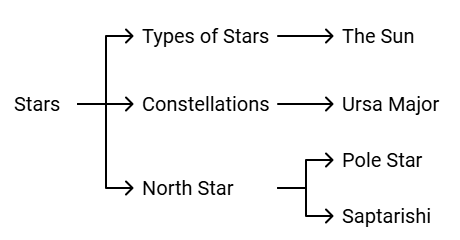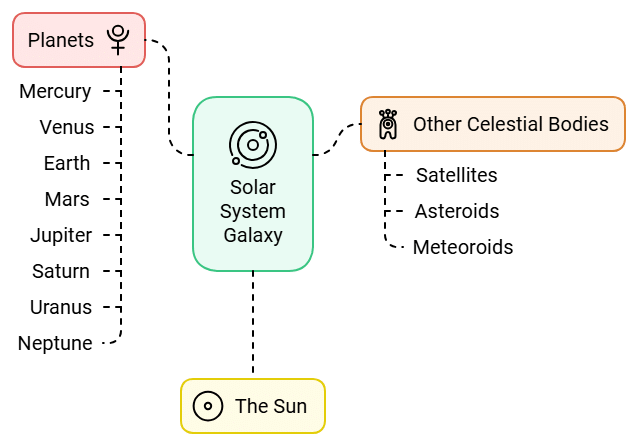CTET & State TET Exam > CTET & State TET Notes > Social Studies & Pedagogy Paper 2 for CTET & TET Exams > NCERT Summary: The Earth in the Solar System
The Earth in the Solar System Summary Class 6 Social Science Chapter 1
Celestial Bodies
- The Sun, the Moon and all other objects shining in the night sky are called Celestial Bodies.
- The moon, stars and planets cannot be seen during the daytime because the very bright light of the Sun does not allow us to see them.
Stars
- Stars are celestial bodies that are very big and hot. They are made up of gases. They have their own heat and light, which they emit in large amounts. The Sun is also a Star.
- Constellations are various patterns formed by different groups of stars. For example, Ursa Major or Big Bear.
- The North Star indicates the north direction. It is also called the Pole Star. It always remains in the same position in the sky. We can locate the Pole Star with the help of Saptarishi.

The Solar System
- The Sun, eight planets, satellites and some other celestial bodies known as asteroids and meteoroids form the Solar System.

The Sun
- The Sun is in the centre of the solar system. It is huge and made up of extremely hot gases.
- It provides the pulling force that binds the solar system.
- It is the ultimate source of heat and light for the solar system.
Question for NCERT Summary: The Earth in the Solar SystemTry yourself: Which celestial body emits its own heat and light?View Solution
Planets
- Planets are celestial bodies that do not have their own heat and light. They are lit by the light of the stars. Earth is a planet too. It gets all its heat and light from the Sun, our nearest star.
- There are eight planets in our Solar System- Mercury, Venus, Earth, Mars, Jupiter, Saturn, Uranus and Neptune.
The Earth
- It is the fifth largest planet by size and is slightly flattened at the poles.
- Its shape is described as a Geoid which means an Earth-like shape.
- It is a unique planet in the Solar System because:
i) Conditions favourable to support life are probably found only on the earth.
ii) It is neither too hot nor too cold.
iii) It has water and air, which are very essential for our survival.
iv) The air has life supporting gases like oxygen. - From the outer space, the Earth appears blue because its two-thirds surface is covered by water. It is, therefore, called a blue planet.
Satellite
- It is a celestial body that moves around the planets in the same way as the planets move around the sun.
- A human-made satellite is an artificial body. It is designed by scientists to gather information about the universe or for communication.
- It is carried by rocket and placed in the orbit around the earth.
The Moon
- The Moon is a satellite and moves around the Earth.
- The only satellite of Earth.
- Its diameter is only one-quarter that of the earth.
- It appears so big because it is nearer to Earth than other celestial bodies.
- It moves around the Earth in about 27 days and takes exactly the same time to complete one spin. Hence, only one side of the moon is visible to us on the earth.
- It has mountains, plains and depressions on its surface.
- The moon appears at different times, in different shapes and at different positions.
- The Full Moon can be seen only once in about a month’s time on the Full Moon night or Poornima.
- A fortnight later, it cannot be seen at all. It is the New Moon night or Amavasya.
Asteroids
- These are numerous tiny bodies which also move around the Sun-like stars, planets and satellites.
- They are found between the orbits of Mars and Jupiter.
Meteoroids
- These are small pieces of rocks which move around the Sun.
- Sometimes they come near the earth and tend to drop upon it.
- During this process due to friction with the air, they get heated up and burn, causing a flash of light.
- Sometimes, a meteor without being completely burnt falls on the earth and creates a hollow.
Galaxy
- It is a huge system of billions of stars, and clouds of dust and gases.
- Our Solar System is a part of the Milky Way galaxy.
- Millions of such galaxies make up the Universe.
The document The Earth in the Solar System Summary Class 6 Social Science Chapter 1 is a part of the CTET & State TET Course Social Studies & Pedagogy Paper 2 for CTET & TET Exams.
All you need of CTET & State TET at this link: CTET & State TET
|
75 videos|322 docs|78 tests
|
FAQs on The Earth in the Solar System Summary Class 6 Social Science Chapter 1
| 1. पृथ्वी का स्थान सौर मंडल में कहाँ है ? |  |
Ans. पृथ्वी सौर मंडल के तीसरे ग्रह के रूप में स्थित है। यह सूर्य से 149.6 मिलियन किलोमीटर (93 मिलियन मील) की दूरी पर है और इसका स्थान उसे जीवन के लिए उपयुक्त बनाता है।
| 2. सौर मंडल में कितने ग्रह हैं ? |  |
Ans. सौर मंडल में कुल आठ ग्रह हैं। ये ग्रह हैं: बुध, शुक्र, पृथ्वी, मंगल, बृहस्पति, शनि, अरुण और वरुण।
| 3. पृथ्वी की विशेषताएँ क्या हैं ? |  |
Ans. पृथ्वी की प्रमुख विशेषताएँ में इसका वातावरण, पानी की उपस्थिति, और जीवन के लिए अनुकूल परिस्थितियाँ शामिल हैं। पृथ्वी का वातावरण नाइट्रोजन और ऑक्सीजन से बना है, जो जीवन के लिए आवश्यक हैं।
| 4. सौर मंडल के अन्य ग्रहों से पृथ्वी कैसे भिन्न है ? |  |
Ans. पृथ्वी अन्य ग्रहों से कई तरीकों से भिन्न है, जैसे कि इसका ठोस सतह, पानी की उपलब्धता, और जीवन का समर्थन करना। अन्य ग्रह जैसे कि बृहस्पति और शनि गैस ग्रह हैं, जबकि मंगल का वातावरण पृथ्वी से बहुत पतला है।
| 5. पृथ्वी को "नीला ग्रह" क्यों कहा जाता है ? |  |
Ans. पृथ्वी को "नीला ग्रह" इसलिए कहा जाता है क्योंकि इसकी सतह का लगभग 71% भाग पानी से ढका हुआ है। जब इसे अंतरिक्ष से देखा जाता है, तो पानी का रंग नीला दिखाई देता है।
Related Searches






















